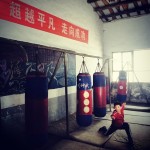This project began as a search into the “last masters” of traditional kungfu. That has always been the core during this process. Every time I went to visit someone, read something, wrote something, or attended an event of some kind, I had the “last masters” in mind.
I went off on a tangent. I became embroiled in MMA, and left behind the evolution – or sundering as I am calling it – of Chinese traditional martial arts from its fundamentals, known by most as traditional kungfu (see this post for more on the malleable terms in wushu), into its component parts: Combat Sports, Wushu Performances, Taiji Health Practices, and Medicine.
To that end, I wrote a series of stories starting with this one in the Economist a while back, “Ain’t that a Kick in the Head,” and continuing with the more recent “Hard Knock Life of a Foreign Fighter in China,” and “The Shady Business of Promoting MMA in China” for Fightland.com, a part of Vice.
I was worried that I may have gone completely off course. I was worried that I may have built a site and proclaimed it part of a “project” that I would never end up completing.




